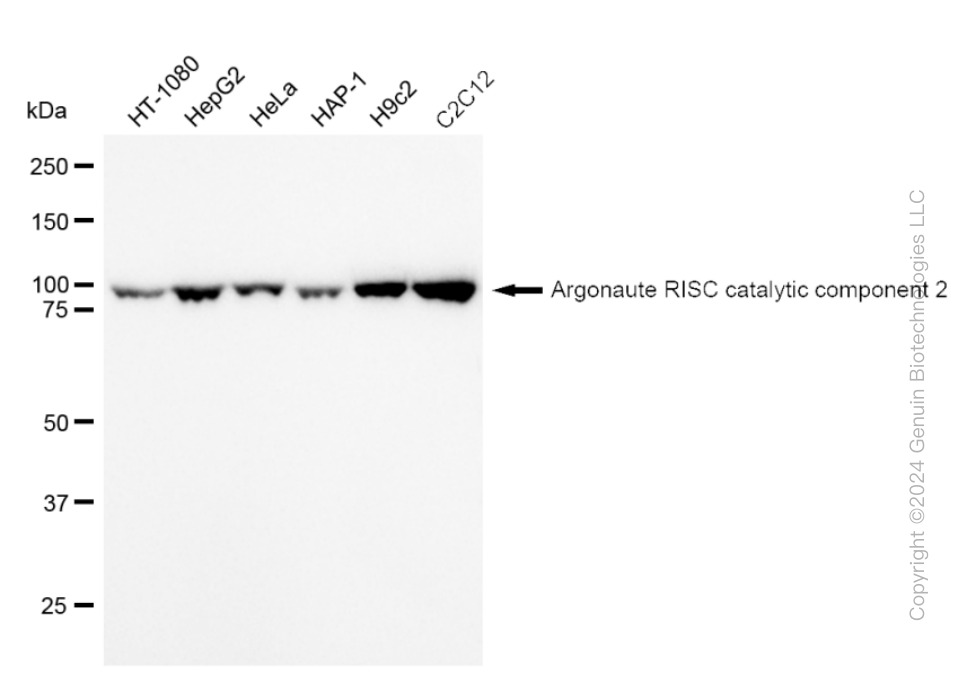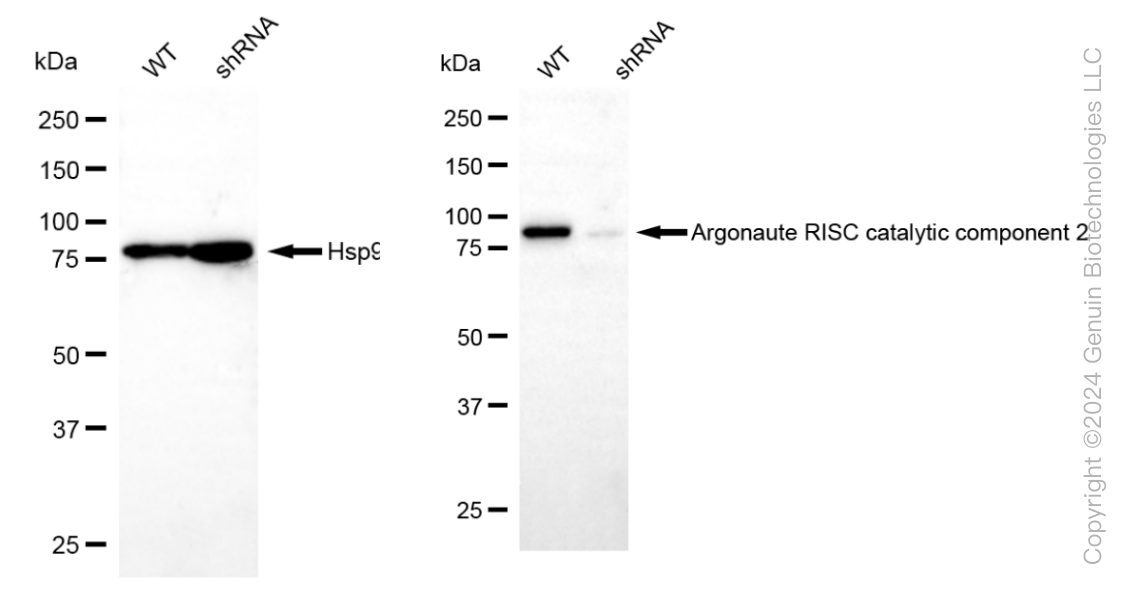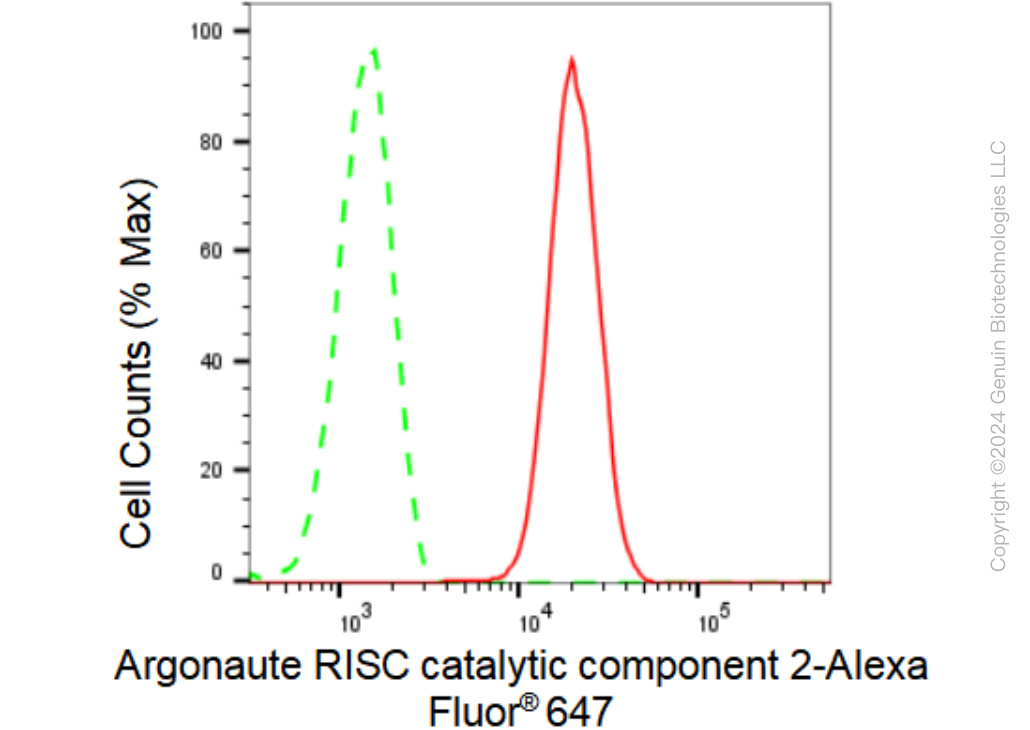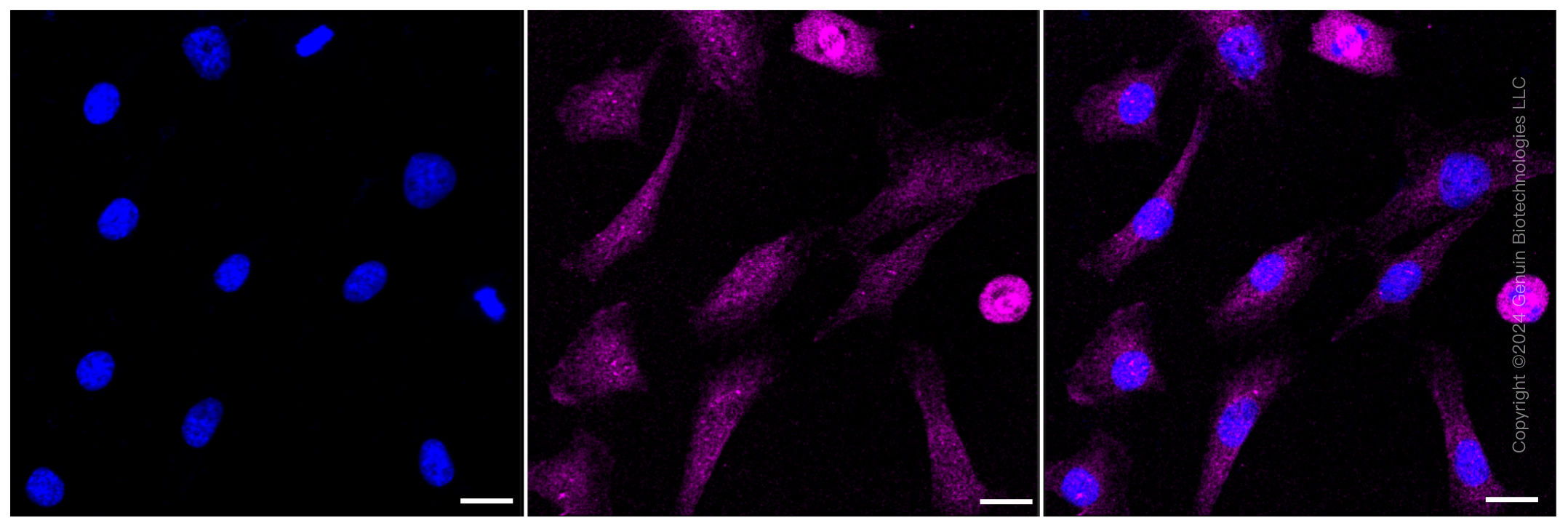KD-Validated Anti-Argonaute RISC catalytic component 2 Rabbit Monoclonal Antibody
Rabbit monoclonal antibody
- SPECIFICATION
- CITATIONS
- PROTOCOLS
- BACKGROUND

Application
| WB, FC, ICC |
|---|---|
| Primary Accession | Q9UKV8 |
| Reactivity | Rat, Human, Mouse |
| Clonality | Monoclonal |
| Isotype | Rabbit IgG |
| Clone Names | 23GB 1790 |
| Calculated MW | Predicted, 97 kDa , observed, 97 kDa |
| Gene Name | AGO2 |
| Aliases | AGO2; Argonaute RISC Catalytic Component 2; LINC00980; EIF2C2; Q10; Cancer Susceptibility Candidate 7 (Non-Protein Coding); Eukaryotic Translation Initiation Factor 2C, 2; PAZ Piwi Domain Protein; Protein Argonaute-2; Protein Slicer; HAGO2; CASC7; PPD; Eukaryotic Translation Initiation Factor 2C 2; Long Intergenic Non-Protein Coding RNA 980; Argonaute 2, RISC Catalytic Component; EC 3.1.26.N2; EC 3.1.26.N1; Argonaute 2; Argonaute2; EIF-2C 2; LESKRES; EIF2C 2; HAgo2 |
| Immunogen | A synthesized peptide derived from human Argonaute 2 |
| Gene ID | 27161 |
|---|---|
| Other Names | Protein argonaute-2 {ECO:0000255|HAMAP-Rule:MF_03031}, Argonaute2 {ECO:0000255|HAMAP-Rule:MF_03031}, hAgo2, 3.1.26.n2 {ECO:0000255|HAMAP-Rule:MF_03031, ECO:0000269|PubMed:15105377, ECO:0000269|PubMed:23746446}, Argonaute RISC catalytic component 2, Eukaryotic translation initiation factor 2C 2 {ECO:0000255|HAMAP-Rule:MF_03031}, eIF-2C 2 {ECO:0000255|HAMAP-Rule:MF_03031}, eIF2C 2 {ECO:0000255|HAMAP-Rule:MF_03031}, PAZ Piwi domain protein, PPD, Protein slicer {ECO:0000255|HAMAP-Rule:MF_03031}, AGO2 (HGNC:3263), EIF2C2 |
| Name | AGO2 (HGNC:3263) |
|---|---|
| Synonyms | EIF2C2 |
| Function | Required for RNA-mediated gene silencing (RNAi) by the RNA- induced silencing complex (RISC). The 'minimal RISC' appears to include AGO2 bound to a short guide RNA such as a microRNA (miRNA) or short interfering RNA (siRNA). These guide RNAs direct RISC to complementary mRNAs that are targets for RISC-mediated gene silencing. The precise mechanism of gene silencing depends on the degree of complementarity between the miRNA or siRNA and its target. Binding of RISC to a perfectly complementary mRNA generally results in silencing due to endonucleolytic cleavage of the mRNA specifically by AGO2. Binding of RISC to a partially complementary mRNA results in silencing through inhibition of translation, and this is independent of endonuclease activity. May inhibit translation initiation by binding to the 7- methylguanosine cap, thereby preventing the recruitment of the translation initiation factor eIF4-E. May also inhibit translation initiation via interaction with EIF6, which itself binds to the 60S ribosomal subunit and prevents its association with the 40S ribosomal subunit. The inhibition of translational initiation leads to the accumulation of the affected mRNA in cytoplasmic processing bodies (P- bodies), where mRNA degradation may subsequently occur. In some cases RISC-mediated translational repression is also observed for miRNAs that perfectly match the 3' untranslated region (3'-UTR). Can also up- regulate the translation of specific mRNAs under certain growth conditions. Binds to the AU element of the 3'-UTR of the TNF (TNF- alpha) mRNA and up-regulates translation under conditions of serum starvation. Also required for transcriptional gene silencing (TGS), in which short RNAs known as antigene RNAs or agRNAs direct the transcriptional repression of complementary promoter regions. |
| Cellular Location | Cytoplasm, P-body. Nucleus Note=Translational repression of mRNAs results in their recruitment to P-bodies. Translocation to the nucleus requires IMP8 |

Thousands of laboratories across the world have published research that depended on the performance of antibodies from Abcepta to advance their research. Check out links to articles that cite our products in major peer-reviewed journals, organized by research category.
info@abcepta.com, and receive a free "I Love Antibodies" mug.
Provided below are standard protocols that you may find useful for product applications.
If you have used an Abcepta product and would like to share how it has performed, please click on the "Submit Review" button and provide the requested information. Our staff will examine and post your review and contact you if needed.
If you have any additional inquiries please email technical services at tech@abcepta.com.














 Foundational characteristics of cancer include proliferation, angiogenesis, migration, evasion of apoptosis, and cellular immortality. Find key markers for these cellular processes and antibodies to detect them.
Foundational characteristics of cancer include proliferation, angiogenesis, migration, evasion of apoptosis, and cellular immortality. Find key markers for these cellular processes and antibodies to detect them. The SUMOplot™ Analysis Program predicts and scores sumoylation sites in your protein. SUMOylation is a post-translational modification involved in various cellular processes, such as nuclear-cytosolic transport, transcriptional regulation, apoptosis, protein stability, response to stress, and progression through the cell cycle.
The SUMOplot™ Analysis Program predicts and scores sumoylation sites in your protein. SUMOylation is a post-translational modification involved in various cellular processes, such as nuclear-cytosolic transport, transcriptional regulation, apoptosis, protein stability, response to stress, and progression through the cell cycle. The Autophagy Receptor Motif Plotter predicts and scores autophagy receptor binding sites in your protein. Identifying proteins connected to this pathway is critical to understanding the role of autophagy in physiological as well as pathological processes such as development, differentiation, neurodegenerative diseases, stress, infection, and cancer.
The Autophagy Receptor Motif Plotter predicts and scores autophagy receptor binding sites in your protein. Identifying proteins connected to this pathway is critical to understanding the role of autophagy in physiological as well as pathological processes such as development, differentiation, neurodegenerative diseases, stress, infection, and cancer.





